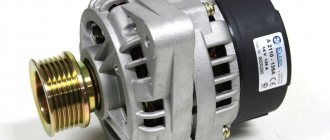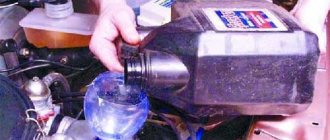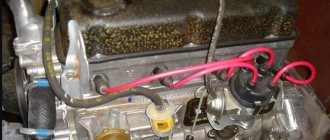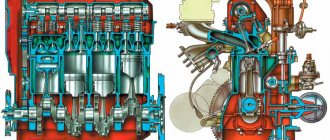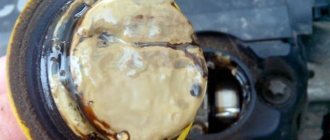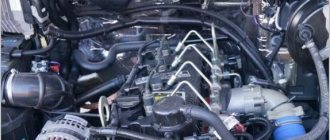The concept of engine flushing oil is probably familiar to every more or less experienced car owner. However, not every driver has personally encountered the fact of using this category of lubricants. Moreover, few people used flushing compounds for their cars.
Flushing oils from different manufacturers
The use of engine flushing products in some cases is not only desirable, but necessary. Unless, of course, the car owner is interested in long-term and trouble-free operation of the engine.
But there is also a downside to the issue, when the use of lubricating fluids or additives in the oil for flushing can cause negative consequences.
In this article we will consider flushing oils, the rationale for their use and possible negative consequences.
Standard oil flush with reduced drain interval
To flush the engine, use regular oil, which is poured into the power unit instead of waste fluid. Then operate the power unit in normal operating mode and perform the next engine fluid change at a reduced interval - this is 3 thousand mileage. After that, the car oil is drained and the same is poured into the engine. It is driven for the full interval regulated by the oil manufacturer.
This flushing method has a clear advantage: a motor mixture with good performance consists of a base base and additives. Additives work effectively for the first few thousand mileage, so they can clean the engine when used in normal operation, without causing any harm to the engine, rubber gaskets, or clogging the internal combustion engine channels.
Among the disadvantages, high cost should be highlighted. This flushing option is quite expensive and requires up to three replacements of the engine mixture and oil filter every 3 thousand kilometers.
Flushing mixtures
Flushing oil is poured into the drive after draining the used engine mixture.
It has an increased amount of detergent additives and a high alkaline number, a reduced amount of anti-wear substances. Thanks to this structure, it ensures maximum dissolution of various deposits. The basic basis of such a washing mixture is obtained by hydrocracking from mineral water. You can wash the power unit with it if, after filling it, the engine runs at idle for up to 10 - 15 minutes. Then this engine fluid is drained and the drive is filled with oil recommended by the dealer for viscosity class and performance properties. Its base can be mineral or synthetic.
Manufacturers of car flushing oils claim that their products after flushing (residues remaining in the engine) have a structure that will not change the characteristics of the filled oil for subsequent operation of the engine.
The advantage of this method is the minimal risk of clogging the oil channels and the absence of aggressive interaction of additives with engine elements.
The disadvantage of this method is the price, flushing mixtures are quite expensive, plus after them it is necessary to use motor fluid of the same brand, using a different brand of motor oil can lead to negative consequences, their compositions will react and the resulting oil will not protect the engine from wear and tear sludge formation.
Flushing the engine lubrication system
You can prevent the need to flush the engine lubrication system by following the vehicle's operating instructions, using the engine oil specified by the car manufacturer and changing it in a timely manner.
Modern motor oil has detergent and dispersant properties, which helps clean engine parts from deposits and sludge that form on them. To prevent new engine oil from becoming contaminated immediately after filling and to serve its intended life, it is advisable to flush the engine before using it. However, this is not done in all cases. Experts advise flushing the lubrication system if the oil is not changed on time, since if the car’s mileage is 10-15% more than prescribed, the oil additives have already worn in, which means that the oil has ceased to properly protect engine parts.
When buying a used car, it is not always possible to accurately find out whether the appropriate engine oil was filled in for a given engine, whether the oil was changed on time, and the condition of the lubrication system itself. If there is no such information, you can pour new oil into the engine and look at its color after 100-200 km. Dark oil indicates severe contamination of the lubrication system and the need to flush it. When unscheduled topping up (> 20% of the volume) with motor oil of another brand, you should remember that not all lubricants are compatible, especially those with different compositions. Mixtures of oils from different brands not only pollute the engine, but also cause increased wear.
If you don’t have the oil recommended by the car manufacturer on hand, and you need to add it urgently, then it is better to purchase a product of the same brand (it is likely that it contains a similar package of additives) and with the same base (mineral, semi-synthetic, synthetic). It is extremely undesirable to pour “synthetics” into a lubrication system with mineral oil. If it is not possible to use the same brand of oil, another brand with the same base and a similar level of performance properties (according to API, ACEA classifications) may be suitable.
The viscosity of the purchased oil (according to SAE) must be no less than that recommended by the manufacturer. Under high load conditions, low viscosity can lead to increased engine wear.
Coolant gets into the oil due to a leak in the cooling system. The most common cause of this is a damaged cylinder head gasket. Even in small quantities, antifreeze causes significant damage to engine oil. Water and ethylene glycol contained in the coolant cause adhesion (coagulation) of contaminants, decomposition (hydrolysis) of additives and accelerated oxidation (aging) of the oil. As a result, the performance of the oil sharply deteriorates, and clumped sediment particles can clog the oil receiver mesh, which will lead to oil starvation of the engine. If possible, it is better not to operate an engine with such a malfunction, and after eliminating the leak, flush the lubrication system.
The main manifestations of pouring low-quality (fake) oil are:
- Severe blackening of the oil after 100-200 km (if you are confident that the lubrication system is clean)
- Black deposits on the inside of the valve cover
- Increased oil consumption
- The appearance of bluish smoke from the exhaust pipe
- Reduced power caused by carbon deposits immobilizing the piston rings after 10-15 hours of operation
If any of these symptoms appear, you must immediately drain the surrogate and flush the lubrication system. Commercially available engine flushing products can be divided into two groups.
- Additives to old oil. These include the so-called “five-minute” ones, which flush the lubrication system while the engine is idling for 5-10 minutes. However, due to the short period of time, they may not wash away all deposits.
- Flushing oils that allow you to operate the car for 200-300 km before changing the oil. When using these low-viscosity fluids, it is undesirable to give the engine high loads, as they provide poorer protection against wear.
Flushing oils, filled in instead of used oil, are designed for short-term engine operation (up to 15 minutes) only at idle. However, even in a preheated engine, the oil may not reach the temperature of +70...+80 °C required for effective flushing of the lubrication system. Driving the car for a short time (30-40 minutes) with a light load on the engine allows the flushing oil to warm up sufficiently - and the higher its temperature, the better the system is flushed.
Since there are no generally accepted classifications for flushing agents, you can only rely on the labels on the packaging, which indicate the method of use. Mineral, synthetic and partially synthetic (semi-synthetic) flushing oils are available for sale. The car owner can choose any of them, regardless of the engine oil used. All flushing agents are universal - used for both gasoline and diesel engines.
When flushing the engine, follow these recommendations:
- It is better to drain old oil from a fully warmed-up engine while driving. It is advisable to keep the drain hole open for at least 5 minutes. In this case, the car must be positioned horizontally
- Before flushing, it is better to replace the oil filter, since the flushing oil will dissolve the contaminants present in it and become less effective. The filter for washing can be purchased from the cheapest commercially available, since it will only act as a plug
- When using the cleaning agent, the instructions must be strictly followed. If it is not in Russian, then it is better to refuse to purchase such a “washing”
- According to experts, there are no special requirements for flushing engines with hydraulic compensators and hydraulic tensioners.
Mixtures - “five-minute” and long-acting
“Five-minute” and long-acting mixtures are concentrates with a large amount of detergent additives, which are poured into the old motor fluid before replacement. The motor runs on such a “cocktail” for 10 minutes, in the case of a “five-minute” up to 200 km (when using a long-acting concentrate). Then the mixture is drained and new oil is poured into the engine.
Using “five minutes” you can remove various deposits in a short period. In addition, flushing and changing the oil are performed as one process.
Of the minuses: such reagents can be used to remove small deposits, plus they can aggressively interact with the material from which engine parts, gaskets, and so on are made.
Types and properties of rinses
From a technical point of view, the flush is made from an inexpensive base oil with the addition of a number of active additives. Depending on the service life of such lubricants, flushing liquids are divided into 3 groups:
- Long-lasting;
- 15 minutes;
- 5 minutes.
Long-term
They suggest operating the car with them for 1-2 days in a gentle mode, that is, without driving at high speeds. Disadvantages include time costs, low oil film stability and active chemical reactions, which lead to damage to engine seals.
Rinsing 5-minute
and
15-minute
oils are poured for a short time, during which the engine is idling. Then everything is drained and fresh oil is added. Today there are two types of such washings. The first involves filling 4-5 liters at once, that is, the full volume, and the second involves adding a special additive in a volume of 300 milliliters to the already old oil.
The effectiveness of modern flushing lies in the increased concentration of active chemicals, which allow dissolving deposits in a short time. At the same time, additives are introduced into such compositions to protect oil seals and seals from damage and destruction due to a protective film.
How not to damage the engine?
We need to clarify right away: when changing the engine mixture, you can flush a diesel engine only with the use of special flushing oils.
Do not use products intended for gasoline engines. This recommendation is explained not only by the different structure of deposits formed on engine elements, but also by the fact that for normal operation of a diesel unit, a larger amount of engine mixture is needed in the friction units; the rubbing elements of the engine must “float” in the lubricant. Oil for flushing power units running on gasoline will not be able to provide such an effect. A similar result is obtained when using “five minutes”; they dilute motor fluids too much. Therefore, special detergents are needed to clean a diesel engine. When choosing a flush, keep in mind: if there is a lack of the necessary additives, you can get the engine jammed. Because the main task of washing is to first loosen contaminants and then dissolve them. Loose deposits will not adhere to the surface of the drive elements, they will come off and fall into the crankcase of the power unit, where the engine mixture is taken, then clog the filter, made in the form of a mesh - this will lead to a decrease in the throughput of the oil pump and provoke dry friction in the components motor. A high-quality additive, with the right amount of reagents, can dissolve loose deposits.
Specifications
Flushing for two types of engines: gasoline and diesel in composition may differ in the set of additives and base.
Such flushes may have the following basic basis:
- mineral;
- synthetic;
- semi-synthetic.
The main difference between technical flushing compounds and motor oils is that the viscosity of the flushing is reduced. This difference is especially noticeable in that the flash point changes, as well as the ash content. This is logical, because such a composition is not designed for long-term work inside the engine, and the emphasis is on cleaning the engine and penetrating into the most secluded places inside the system. That is why the viscosity of the oil should be lower than that of conventional motor lubricant.
Good washing mixtures should contain:
- detergent additives;
- dispersing compositions;
- stabilizers;
- additives that prevent wear.
Also, in the production of flushing oils for diesel engines, unique substances are added that are not found in flushing oils for gasoline engines.
What is the best way to flush the engine when changing the oil - expert advice
Often, a vehicle owner is faced with the task of cleaning the power unit before replacing the lubricant. Most often, this is required when purchasing used equipment, when it is not clear under what conditions the car was operated, what condition the engine is in, and what kind of oil was filled previously. However, engine flushing is also required for cars with high mileage, when switching to another type of engine lubricant, when low-quality fuel gets into the engine, and in some other cases. Several methods can be used for cleaning.
In what situations is it necessary to use flushing oil?
Very often, car enthusiasts argue about whether flushing oil is needed when changing the oil. Some believe that this procedure does not bring any benefit and does not affect the wear of the engine in any way, but on the contrary, it only brings harm. Others are sure that flushing is indispensable and must be performed every time the MM is replaced. In the first case, there is only a grain of truth, since flushing oil cannot damage the engine, so such “opponents” most likely mean aggressive five-minute fluids. On the other hand, washing the engine is not always justified.
This is interesting: The Citroen family of minivans will be replenished with a manual transmission - especially for Russia
First of all, it is worth saying that all motor oils contain various additives that have detergent, extreme pressure, antioxidant and other properties. If the vehicle is operated correctly and only high-quality gasoline is poured, then no deposits should remain on the engine parts. However, where is the guarantee that the gas station you visit every day sells only high-quality petroleum products?
If we talk about when flushing is definitely not needed, then you can safely do without this operation if you:
- purchased a completely new car;
- you have never poured cheap oil into your engine or are completely confident in the quality of the fluid you constantly use;
- You completely trust the quality of fuel at the gas station.
If we talk about when to use flushing oil for a diesel or gasoline engine, then everything is obvious:
- when purchasing a used car;
- with frequent changes of different gas stations;
- if antifreeze gets into the engine;
- after mixing different lubricating fluids;
- when switching to another MM classification (for example, from SAE to API).
The washing process itself does not differ in any particularities, so you can do it yourself.
Why do you need to flush the power unit?
Long-term operation of a vehicle often leads to the appearance of various types of contaminants that settle on the parts of the power unit and its internal walls.
Important! Regardless of the nature of the deposits, they should not be in the engine. Otherwise, the engine must be washed.
What type of dirt can appear in the engine and what causes its occurrence:
The appearance of contamination can be caused by pouring low-quality oil, difficult operating conditions of the power unit, violation of vehicle maintenance regulations, low quality fuel, etc. They are formed gradually. Removing deposits is one of the functions of high-quality lubrication. But sometimes she cannot cope with this task properly.
Important! It is recommended to regularly flush turbo engines, as they have quite fine tuning.
Understanding that the engine is dirty is not so difficult. It is enough to unscrew the neck cap and examine the insides (sometimes it is necessary to remove the valve cover).
A clean motor does not require any flushing. There is no point in carrying out this event for preventive purposes. You need to understand that a small part of the flushing fluid remains in the lubrication system in any case, worsening the characteristics of the oil that is subsequently filled. And modern lubricants already contain all the necessary additives that are able to remove contaminants formed during operation and ensure normal engine operation. Timely replacement of the lubricant and the use of oil recommended by the vehicle manufacturer will have a much better effect on the operation of the power unit.
If the engine does become dirty, in some cases the owner of the car has to go to a service station and have it sanitized in order to prevent the unit from failing. But often flushing fluids help solve the problem.
Why flush the engine?
What should I do, you ask?! You don’t have to do anything, you just have to wash it, that’s all.
Many people are skeptical about engine flushing, for good reason. A lot of junk has appeared on the market, supposedly washing products that contain an ultra-high solvent and are in no way suitable for the engine. Don't pay attention to cheap washes.
DO NOT grab the first one you see off the store shelf.
A good flush is a product that will restore compression in the engine cylinders, effectively remove sludge and dirt, and not only allow it to fall off, but also dissolve it, so that it does not clog the channels and is easily removed from the mixture system. Also, a good flush should cover all microscopic defects in the engine, and restore both the oil seals and all rubber seals.
Best flushing oil
Today there are many flushing compounds on the market, including those from leading motor oil manufacturers.
Spectrol MOTOR CLEANER
The domestically produced composition carefully cleans the engine of accumulated deposits and waste lubricant residues, and also protects the lubrication system. It is characterized by decent cleaning and anti-corrosion properties.
Advantages of using oil:
PROMO
Flushing from Gazpromneft is intended for cleaning the lubrication systems of engines of passenger cars, commercial and special vehicles running on gasoline and diesel fuel.
The use of this product, thanks to the additives contained in the composition, allows you to remove most high- and low-temperature deposits from the engine. As a result, the oil receiver mesh, oil pan, oil channels and other components and parts of the power unit are cleaned.
Express
Flushing from the Rosneft company is popular with both car owners and service station workers. This oil is produced on a mineral basis with the addition of detergent-dispersant components (the complex was developed jointly by domestic and foreign specialists). The composition is used to clean the lubrication system of gasoline and diesel power units of vehicles of any manufacturer before changing the engine oil.
Express is able to cope even with significant deposits in older engines. At the same time, it does not have a negative effect on the sealing elements.
How to use the oil:
When flushing, all particles contaminating the engine are kept in suspension, which prevents clogging of the oil system channels.
If the motor is very dirty, washing can be repeated.
It should be noted that flushing from Rosneft received official approval from the Volzhsky Automobile Plant.
Lucas AI Innovations
The scope of application of this composition is the flushing of diesel engines exclusively. The demand for the liquid is explained by its good price/quality ratio. After using the oil, noise and the risk of engine overheating are reduced, and the consumption of the fuel mixture is reduced. But it cannot be used in cold weather.
Lukoil Flushing oil
This inexpensive, good quality oil can be used to flush the engines of all brands of cars assembled at AvtoVAZ and foreign cars whose assembly lines are located in Russia.
The composition, made on a mineral base, is reinforced with additives (ZDDP to minimize wear, calcium, which neutralizes the acidic environment from mining and some others). As a result, the liquid received good cleaning, anti-wear and anti-corrosion properties. The oil can be used to clean the lubrication systems of gasoline and diesel engines without disassembling them. Using the composition helps to effectively remove contaminants from the engine within a short period of time.
Advantages of using this brand of washing:
Eneos Flush
The oil is suitable for flushing gasoline and diesel engines of domestic and foreign vehicles. It has excellent cleaning properties. All deposits are kept in suspension, which prevents the channels from clogging.
However, the cost of the liquid cannot be called affordable (although most of those who have tried it in practice consider the high price to be fully consistent with the effect of its use). It is not recommended to pour the composition into very old engines. Another aspect that scares many people is the large number of fakes on the market.
Why do you need to flush the engine before changing the oil?
Engine before and after flushing
The general purpose of flushing the engine is to dissolve and remove from the lubrication system deposits formed from dirty, burnt, not changed for a long time or simply low-quality oil. In more detail, three tasks stand out:
- Cleaning channels . Blockage of thin holes and cracks leads to the fact that the lubricant does not spread everywhere, or in an insufficient volume.
- Improved heat dissipation . Deposits in the form of soot impair the removal of heat from rubbing parts. Lack or complete absence of lubrication is guaranteed to lead to overheating.
- Preventing oil starvation . To avoid this, the lubricant must be normally taken from the sump, pass through the filter, and then be properly distributed through the channels and cracks to all rubbing surfaces.
Many people are also familiar with the situation when, after filling in fresh engine oil and checking its level, traces of waste are observed on the dipstick. This is a bad signal, and washing can get rid of it.
How to properly flush the engine with diesel fuel before changing the oil
Proper engine care is one of the most important tasks in car maintenance. Every owner who is attentive to his car knows that the performance of the car as a whole depends on the quality of service and functionality of the engine. Many car owners, when the time for scheduled maintenance of the car approaches, drive it to a service center, where specialists carry out all the necessary procedures in accordance with the regulations, however, there are also those who prefer to carry out simple service work on their own. In this article we will talk about the procedure for flushing the engine when changing the oil, the need for which has some controversy regarding the frequency of such a process and the type of flushing fluid. Let's consider whether flushing the engine with diesel fuel before changing the oil, which was used in ancient times and remains relevant today, is justified, let's talk about the advantages and disadvantages of this method of dealing with deposits in the power unit, and also tell you how to correctly carry out this procedure.
When you don't need to flush the engine
There are also a number of cases when the washing process is not required at all:
- You are the first and only owner of the car.
- You always changed your engine oil on time and filled in with high-quality synthetic fluids.
- There is complete confidence in the car service center where the work was carried out (the mechanics certainly did not cheat by not changing the oil at all or replacing it with a cheaper one).
- You have never had to urgently add “not your own oil” to the one that is already running in the engine.
Why do you need to flush the engine with diesel fuel?
The fact that it is necessary to change the engine oil according to the regulations is known to all car owners; it is explained by the loss of the lubricant’s protective properties during operation and a decrease in the efficiency of its operation. Many articles have been written about the regulations and the need to change the lubricant in the engine, however, it is rarely mentioned that before adding new lubricant it is necessary to wash the unit from the inside. How do professionals explain this need, and how often should the procedure be performed?
The need to flush the power unit arises in the following situations:
These precedents necessitate mandatory flushing of the power unit. In addition, flushing the engine may be necessary if the car is operated in extreme or difficult conditions, high-speed and high-temperature conditions, which provokes the formation of scale on the internal surfaces of the unit, which blocks the oil passages. You can determine the need to flush the engine by inspecting the drained liquid: if there are large particles, flakes and sludge in the waste, you will need to clean the engine from the inside in order to remove components that are dangerous to the engine.
Nowadays, service center employees recommend flushing with special liquids that are designed to clean the power unit before changing the oil. Why then did the question of flushing with diesel fuel arise? Several decades ago, the number of cars on the country’s roads was much smaller, and not every family could boast of a personal car, and accordingly, the range of fluids for servicing the engine was limited to several types of oils and diesel fuel as a means for washing it. Today the market situation has changed, but the habit remains. Many car owners still wash their engines with diesel fuel themselves and recommend this procedure to others. Moreover, some explain this fact by savings, while others indicate the high efficiency of diesel fuel as a flushing liquid.
Today, the theory about the high usefulness and quality of engine flushing with diesel fuel has both adherents and opponents, and in almost equal quantities, which forces car owners to understand for themselves the pros and cons of such a procedure, and as a result, make an independent decision in favor of a flush emulsion - choose a modern liquid or give preference to diesel fuel.
Is it necessary to flush the engine and when should it be done?
Carrying out a flush just because it was recommended by second-rate car repair shops is impractical and, at best, pointless, and at worst, it can cause serious engine damage. This procedure is important to carry out in the following cases:
- The car was previously owned by another owner, and the new one has no idea what kind of engine oil was used. In this case, washing is necessary, but very carefully and delicately. In most cases, they resort to flushing the engine with new oil.
- The car owner changes the lubricant, for example, switches from synthetics to mineral water. In this case, it is advisable to flush the engine, but not necessary.
- A completely new car, its owner takes care of the condition of its components and assemblies. In this case, flushing procedures are carried out regularly.
- A turbocharged engine or a heavily used vehicle.
- An old car with deposits under the valve covers and in the pan. The diagnostics carried out will indicate the need for thorough washing, and the procedure in this case is carried out by removing the cover and pan.
In the first situation, when the new owner of the car does not know what kind of oil was used before, flushing is mandatory and is associated with the presence of additives in the lubricant. Such additives are not found in cheap and low-quality formulations; accordingly, they do not protect the engine from the formation of deposits.
If the engine oil is changed when switching from synthetics to mineral water or vice versa, then first fill in the flushing oil. This way they get rid of old additives: there is a high probability that they will completely leave the system and will not react with new ones.
Regularly flushing the engine of a new car helps avoid deposits on parts. If the car is used actively and in difficult conditions, then it is recommended to wash the engine even in passenger cars.
Engine requiring urgent flushing
Experts do not recommend flushing the engine only in two cases:
- if the car is under warranty (since it does not provide for such procedures, in case of violation the car may be removed from service);
- if high-quality synthetics or semi-synthetics are poured into the engine.
Pros and cons of diesel fuel as a flushing fluid
Indeed, one of the advantages of diesel fuel in comparison with special means is the pricing policy. Flushing the engine with diesel fuel before changing the oil will be much cheaper than carrying out this procedure using purchased emulsions. The second argument in favor of diesel fuel is its use in all CIS countries for cleaning engines of domestically produced equipment, as well as its applicability for engines of special equipment. The effectiveness of this method is proven by the large number of domestically produced cars on the roads at the present time, which perfectly perform their functions despite their advanced age.
But the following fact casts doubt on the benefits of diesel fuel for the engine. Many users explain the effectiveness of diesel fuel when flushing the engine before changing the oil by the fact that it is actively used to clean engine elements during major repairs by professionals. And this is true, diesel fuel actively cleanses the elements of scale, dirt and sludge. However, opponents of the theory argue that when cleaning parts during a major overhaul, these components are not only affected by diesel fuel, but also a significant mechanical force is applied, due to which a positive result is achieved.
In addition, many experts note that when flushing the engine, diesel fuel does not break down the scale on the parts, but acts by peeling it off from the internal surfaces. Since it is almost impossible to completely remove these particles during the washing process, some of the coarse components will remain in the engine, and when oil is added, the particles will freely circulate through the system, causing damage to it and blocking small passages, thereby causing oil starvation of individual engine components. Additionally, doubts about the effectiveness of diesel fuel in cleaning the power unit are caused by the effect of the liquid on oil seals, gaskets and seals. Diesel fuel can cause their deformation, which will affect not only the functionality of the motor, but also its performance characteristics, and can cause its premature failure.
The process of flushing the engine with diesel fuel
If, after weighing all the pros and cons, you decide to clean the engine with diesel fuel, you trust more in the experience of your ancestors, which has proven its effectiveness over the years, than in modern liquids, we will tell you how to carry out this procedure correctly and correctly. The methodology for flushing the engine with diesel fuel when changing the oil is not particularly complicated or requires significant investment. To complete this task, you will need to stock up on diesel fuel, in a volume of at least eight liters, two oil filters, one of which must be of high quality, preferably an original element for your car, the other can be the cheapest, since it will only be used when cleaning the power unit.
The procedure is carried out immediately after draining the used oil. It is recommended to drain the waste in a pit or overpass, on a warm engine, through the oil drain hole on the crankcase pan. Sometimes this will require removing the power unit protection, if it is provided by the vehicle modification. Detailed instructions for changing the fluid in the power unit for a specific car model can be found in the user manual or in articles on this topic on our website. After draining the used motor oil, you need to dismantle the worn-out oil filter and install a purchased filter element in its place.
The further task of the performer is to flush the engine as much as possible from dirt and sludge. To do this, the engine is first cleaned of coarse particles and oil residues by passing diesel fuel through the system. The oil drain hole is left open, and diesel fuel is poured into the filler opening with maximum pressure. It is important to first place a container for the waste liquid under the drain hole. To complete this procedure, you will need about three liters of liquid.
The next step is a better cleaning of the unit components and hard-to-reach areas. For this purpose, the drain opening is closed and diesel fuel is poured in in a volume equal to the amount of motor oil in the car engine. Next, you need to start the car and drive the flushing emulsion through the system, maintaining speed, but without bringing the power unit to operating temperatures. This point is very important, since at high speeds diesel fuel will not be able to cope with the assigned tasks, causing harm to the contacting parts.
After this procedure, the flushing liquid is drained, and the quality of the flowing emulsion is visually monitored. If the diesel fuel comes out too contaminated, with particles of sludge, it is important to carry out this procedure again. Flushing should be carried out until clean fuel begins to flow out of the drain hole, without any impurities in it. At this stage, engine flushing can be considered complete. Next, you should replace the temporary oil filter with a new, original product, tighten the drain cap tightly, having previously cleaned it of dirt and accumulations, and, if necessary, change the seal between the opening and the plug, if it is provided for by the design. The final stage is pouring new motor oil into the vehicle engine. After replacing the lubricating emulsion, it is important to break in the engine - drive the car for about five kilometers in a quiet mode, check the oil level again, if necessary, add it to the level, inspect the butt joints for lubricant leaks.
Since diesel fuel does not have sufficient cleaning and lubricating properties, which are required for the normal functioning of the engine, for the first few kilometers, until the oil is distributed evenly among the components, it is important not to operate the vehicle in an aggressive mode. To eliminate the danger of abrasion of contacting elements, some car owners recommend flushing the engine not with pure diesel fuel, but diluted in equal proportions with inexpensive motor oil, however, the feasibility of such a procedure has not been proven.
Methods for cleaning a car engine
Let's look at several ways to effectively clean the engine of carbon deposits and sludge.
1. In spare parts stores you can find a product such as, for example, motor oil with a viscosity of SAE 40. This is a seasonal summer product that has a fairly high cleaning power and effectively cleans the engine.
Drain the used engine oil and refill with this oil without changing the oil filter. Start the engine and idle for about 15-30 minutes, you can take it for a ride a little. Then drain the oil, most likely it will be black, as it will collect all the dirt that has collected on the walls, parts, etc. Repeat everything done previously until the color of the oil is the same as you poured it.
This is one of the best ways to flush the engine, and after the clean oil is drained, you will be sure that the engine is clean.
Result. After this method of flushing the engine of a problematic 1992 Ford Explorer, oil and fuel consumption decreased, the engine began to run quieter, the car became smoother and more responsive.
2. The second way is to wash the engine well. Flushing from Liqui Moly Engine flush is a five-minute process among the common people that has long deserved recognition. It is poured into the engine with used oil, the engine warms up for about 10 minutes and then drained. Excellent product, easy to use, and most importantly effective.
Always take it as a consumable when changing engine oil. Long-term flushing is also suitable here if everything is really bad.
Fill it up 300 km away. before the shift, the cleaning will already begin.
Let's sum it up
Diesel oil has been used by car owners for many decades as an effective and gentle means for washing the power unit. Today, the effectiveness of the diesel fuel flushing procedure is questioned by many automakers and service center employees; alternatives are considered to be the use of specific liquids to clean the engine. However, a detailed study of the composition of special emulsions for washing the engine raises doubts and controversial issues, since effective removal of soot and dirt using special liquids is achieved due to the presence of aggressive chemical components in them, which can also negatively affect the unit components.
As many years of practice have proven, the method of flushing the engine with diesel fuel has a right to exist, is characterized by high efficiency against the backdrop of low costs, and is considered a gentle way to clean the engine. Each car owner has the right to decide independently which product to choose; however, when performing the flushing, you should act very carefully, follow the instructions, do not overheat the engine - and the result will live up to expectations. Better yet, keep an eye on the engine of your car, try to avoid overheating and stress, change the oil in a timely manner - and the engine will not need such procedures.
Source
